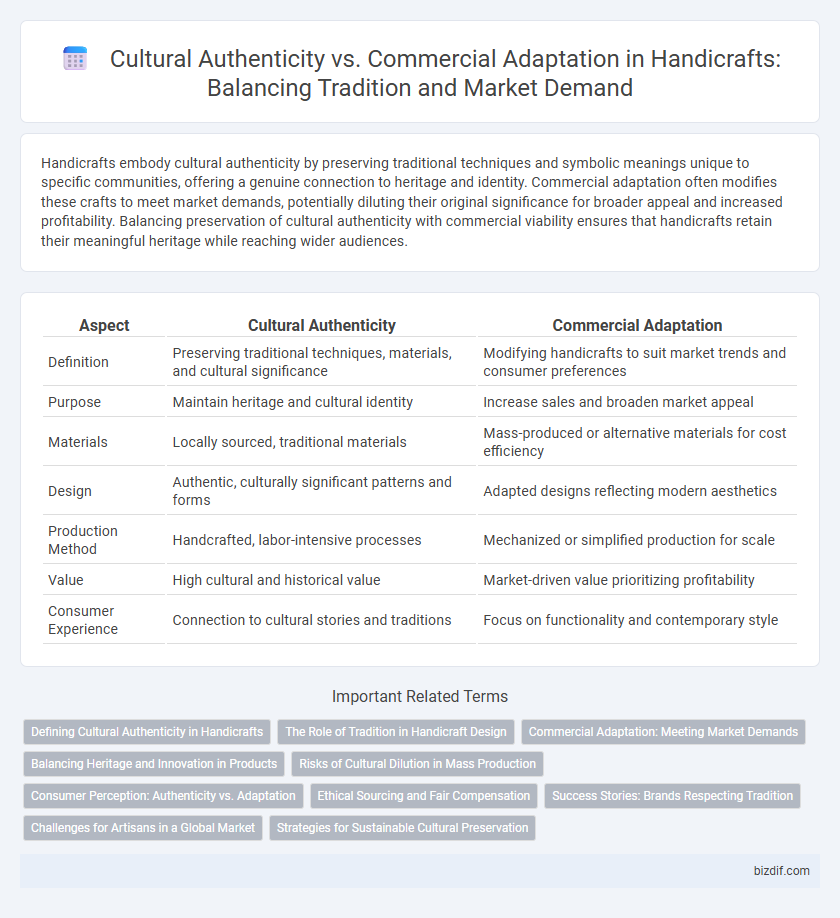Handicrafts embody cultural authenticity by preserving traditional techniques and symbolic meanings unique to specific communities, offering a genuine connection to heritage and identity. Commercial adaptation often modifies these crafts to meet market demands, potentially diluting their original significance for broader appeal and increased profitability. Balancing preservation of cultural authenticity with commercial viability ensures that handicrafts retain their meaningful heritage while reaching wider audiences.
Table of Comparison
| Aspect | Cultural Authenticity | Commercial Adaptation |
|---|---|---|
| Definition | Preserving traditional techniques, materials, and cultural significance | Modifying handicrafts to suit market trends and consumer preferences |
| Purpose | Maintain heritage and cultural identity | Increase sales and broaden market appeal |
| Materials | Locally sourced, traditional materials | Mass-produced or alternative materials for cost efficiency |
| Design | Authentic, culturally significant patterns and forms | Adapted designs reflecting modern aesthetics |
| Production Method | Handcrafted, labor-intensive processes | Mechanized or simplified production for scale |
| Value | High cultural and historical value | Market-driven value prioritizing profitability |
| Consumer Experience | Connection to cultural stories and traditions | Focus on functionality and contemporary style |
Defining Cultural Authenticity in Handicrafts
Cultural authenticity in handicrafts is defined by the preservation of traditional techniques, materials, and symbolic meanings passed down through generations. It embodies the cultural heritage and identity of the community, reflecting its history, values, and craftsmanship. Maintaining authenticity ensures that handicrafts remain genuine representations rather than commercial adaptations designed solely for mass-market appeal.
The Role of Tradition in Handicraft Design
Tradition serves as the foundation of handicraft design, preserving cultural authenticity through time-honored techniques and symbolic motifs integral to the identity of artisan communities. The role of tradition ensures that each handcrafted piece embodies historical narratives and cultural values, reinforcing a tangible connection to heritage. Balancing tradition with modern influences allows artisans to adapt designs for commercial markets without compromising the cultural integrity that defines authentic handicrafts.
Commercial Adaptation: Meeting Market Demands
Commercial adaptation in handicrafts emphasizes aligning traditional designs with current market trends to enhance consumer appeal. Artisans modify patterns, materials, and production techniques to balance authenticity with commercial viability, ensuring products remain competitive. This strategy increases sales potential while preserving distinctive cultural elements in a market-driven context.
Balancing Heritage and Innovation in Products
Preserving cultural authenticity in handicrafts ensures the continuation of traditional techniques and symbolic meanings unique to specific communities, enhancing the heritage value of each piece. Commercial adaptation introduces innovative designs and materials to meet contemporary market demands, expanding the audience while risking dilution of original cultural significance. Striking a balance between heritage preservation and innovation fosters sustainable craftsmanship, supporting artisans' livelihoods and keeping cultural narratives alive in evolving product offerings.
Risks of Cultural Dilution in Mass Production
Mass production of handicrafts poses significant risks of cultural dilution by prioritizing quantity over traditional techniques and symbolic meanings embedded in artisanal work. When cultural elements are simplified or altered to meet commercial demands, the authentic heritage and unique storytelling of indigenous communities can be compromised. This commodification not only erodes the cultural identity of the craft but also diminishes its value and reverence in both local and global markets.
Consumer Perception: Authenticity vs. Adaptation
Consumers often associate cultural authenticity in handicrafts with traditional techniques, indigenous materials, and genuine storytelling that reflect the artisan's heritage. Commercial adaptation, while modifying designs or materials for broader market appeal, may be perceived as less authentic but more accessible and trendy. Balancing authenticity and adaptation influences consumer trust, perceived value, and willingness to pay premium prices for unique, culturally rich handicrafts.
Ethical Sourcing and Fair Compensation
Ethical sourcing in handicrafts ensures that materials and labor reflect cultural authenticity, preserving traditional techniques while supporting artisan communities. Fair compensation provides artisans with equitable wages, fostering sustainable livelihoods and empowering local economies. Balancing cultural heritage with commercial adaptation requires transparency and respect for the creators' rights to maintain integrity and promote ethical trade practices.
Success Stories: Brands Respecting Tradition
Successful handicraft brands like Ten Thousand Villages and Siddi Crafts excel by maintaining cultural authenticity while adapting designs for global markets. These brands collaborate closely with artisans, preserving traditional techniques such as block printing and hand embroidery, ensuring each piece reflects its cultural heritage. Their commitment to ethical sourcing and fair trade strengthens communities, blending commercial success with respect for craft traditions.
Challenges for Artisans in a Global Market
Artisans face significant challenges maintaining cultural authenticity as global markets often demand adaptations to meet commercial trends, risking the loss of traditional techniques and symbolism. Balancing heritage preservation with market competitiveness requires navigating pressures to scale production and modify designs without compromising cultural integrity. Limited access to fair trade platforms and inadequate intellectual property protections further exacerbate difficulties in sustainably promoting genuine handicrafts worldwide.
Strategies for Sustainable Cultural Preservation
Balancing cultural authenticity with commercial adaptation requires integrating traditional craftsmanship techniques with market-driven design innovations that respect cultural heritage. Employing community-based participatory methods empowers local artisans, ensuring that economic benefits support cultural sustainability and intergenerational knowledge transfer. Developing certification systems and storytelling marketing strategies enhances consumer awareness, fostering demand for genuine, ethically produced handicrafts that preserve cultural identity.
Cultural Authenticity vs Commercial Adaptation Infographic

 bizdif.com
bizdif.com